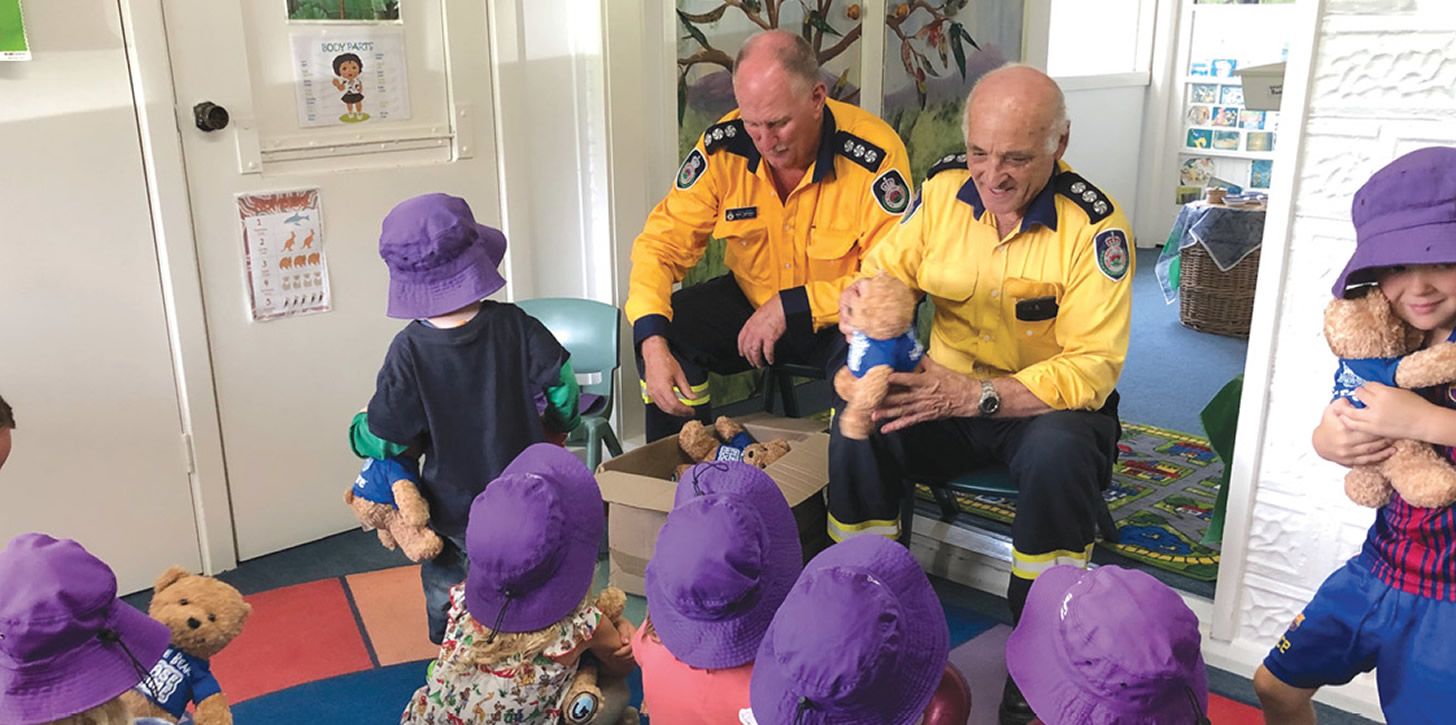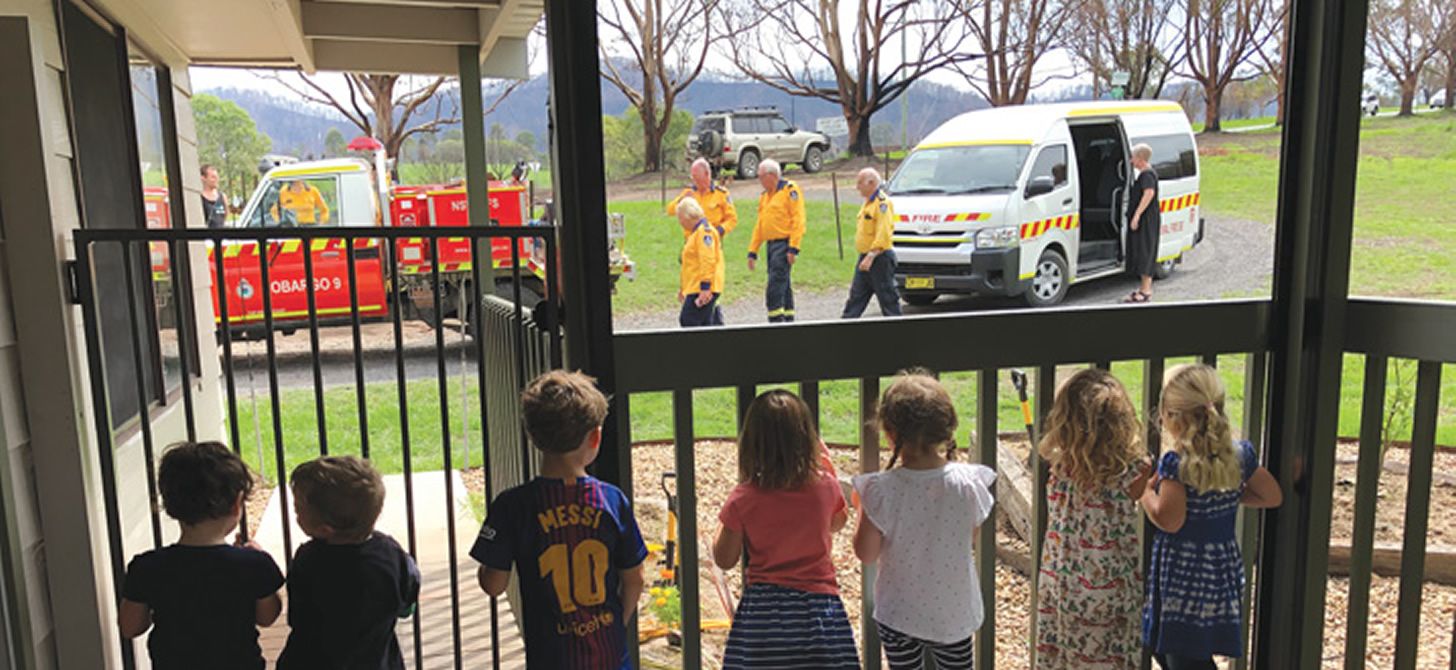
Australia’s rolling natural disasters and the coronavirus are understandably instilling fears in some young children. IEU journalist Monica Crouch asks three experts how they work with preschoolers’ anxieties.










































































































































High anxiety: Supporting children through stressful times
2020 May Bedrock


Australia’s rolling natural disasters and the coronavirus are understandably instilling fears in some young children. IEU journalist Monica Crouch asks three experts how they work with preschoolers’ anxieties.

Drought, bushfires, floods and the coronavirus pandemic have inevitably disrupted the lives of Australia’s young children, in some cases giving rise to anxiety. Teachers in preschools, kindergartens and long daycare centres are tasked with managing very young minds in these complex and constantly changing situations. So what do they need to look out for and how do they work with it?

“There’s been a number of crises that children and families have had to contend with in a very short period,” said psychologist Helen Tsamoulos (pictured middle right), who works with children, adolescents and families in assessment and counselling.
For some young children the past six months have delivered shock, loss and grief; for others there have been upended routines, cancelled activities and separation from friends and some family members. Young children are not oblivious to the news and community concerns, but they don’t necessarily have the language to express their responses. “Children might internalise or externalise some of that stress, then present as an anxiety situation,” Tsamoulos said.
The director of Emerging Minds, the National Workforce Centre for Child Mental Health, Brad Morgan (pictured bottom right), says children need more reassurance than ever to support their social and emotional wellbeing at this time.
“We know that children rely on the adults in their life – not just their parents and family members but also teachers – for cues on how to make sense of government restrictions and find a new rhythm in what is and isn’t possible,” Morgan said.
Tsamoulos agrees. “Children in that 0-5 age group are very much in a stage where they look to adults for guidance around how they respond in situations,” she said.
“They’re still in those formative years of learning strategies and skills, so a lot modelling and scaffolding that we do as adults around children of that age is very important.”
Stress, anxiety and trauma are part of a continuum, and each is not easily defined, especially as individual children will respond differently to any given situation. “Stress can be positive or negative,” Tsamoulos said. “With the coronavirus, children might be a bit uncertain about what is happening and might be stressful, but they might not necessarily respond in a negative way because they’re being guided by parents or teachers, so they might be adjusting well.”
But some are struggling and teachers can look for both obvious and subtle signs. “Anything that’s outside the norm of what the child presents within your average day would indicate there’s something happening emotionally for that child that they may not be coping with well,” Tsamoulos said.
The director of Cobargo Preschool, IEU member Christine McKnight (pictured above, with children), witnessed stark differences in her young students after the horrific bushfires that ravaged their town on New Year’s Eve 2019. Of the 20 children at the preschool at the time, 10 lost their homes and a further seven experienced substantial damage to the properties where they lived. Most had gone through hurried evacuations.
“They were sort of on the surface alright, but they were quiet and they were different, or they were noisy and different,” McKnight said. “They were just different in their own ways. They started to interact a bit differently – some who had previously been really vocal and out there and involved in everything had gone really quiet, and it took a while for those children to start to feel more comfortable again.”
To McKnight’s surprise, the children were keen to engage in “fire play”. “The first thing a child who had lost everything did was ask for the fire engine,” she said. She questioned if this was appropriate but followed her instinct and went with it. “They played fire engines for weeks, so we had a lot of screaming around the playground. They just needed to do it.”
McKnight also noticed that the children’s play had become particularly loud. “And not in a normal sort of children’s loud way, they seemed to need to make a lot of noise,” she said. “It seemed to me they just needed to be heard – to be bigger, to re-establish themselves. Everything they did was loud, they’d even walk loudly, it was noticeable.”
While the Cobargo children grew loud, Tsamoulos says children have other ways of externalising stress or anxiety. “They might become more aggressive or they might be less compliant and have more meltdowns, more tantrums,” she said. “On the other hand, they might internalise it. They might isolate rather than be among others, or it might impact on their sleep and on their eating.”
Morgan lists a range of behaviours that may indicate anxiety, including “frozen” expressions, uncontrolled crying, and persistent physical complaints such as nausea, stomach aches, headaches, and loss of bladder or bowel control. Other indicators include clinginess, wanting to check in on parents and siblings, “acting out” to get attention or “people pleasing” so as to avoid upsetting adults around them.
There are several strategies teachers can implement to ease children’s fears. “As educators, it will be important to provide plenty of opportunities for children to talk through their feelings, if that’s what they want to do,” Morgan said. “Within the physical and virtual classroom, it’s critical children are listened to, reassured and supported.”
While each child is different, Tsamoulos recommends identifying emerging and unfamiliar emotions. “Being able to name and normalise the feelings children have is very important in validating fears – they’re quite real for the child,” she said.
“At the moment it’s over things that are quite significant, but sometimes it can be over things that might not seem as significant, so validating that the child feels strongly about something is important.”
After talks with staff and a trauma counsellor, McKnight and her team decided not to initiate discussion with the children about the fires, but allow them to lead and support them should they want to bring it up.
It was a counterintuitive event that coaxed the Cobargo children into talking: a visit from the local fireys. “Normally when the fireys come there’s great excitement because they bring the siren and they make a lot of noise and it’s a lot of fun,” she said. “But this time the children were quite hesitant when they arrived.”
The fireys understood this. “They sat down and played with the children and it was really quite lovely and gentle,” McKnight said. When it came time to leave, the fireys asked if the children wanted to hear the siren. “My first thought was ‘no’,” McKnight said, but she decided to let the children take charge. Reluctant at first, the children decided they wanted the siren after all. McKnight suggested they get as loud as the siren, and the children responded enthusiastically.
“We made it part of a game, and we drowned out that siren,” she said. “It was a really positive thing for them to do. Then after the fireys left, the children came inside and they all started talking, and it was at that point we had them saying ‘we lost our home’, ‘we used to have a swimming pool’, ‘we lost our animals’, lots of little things. It allowed them to start talking about it, and it enabled them to start engaging in more direct conversations. So it was that community input that triggered a response that meant we could share about the fires more openly.”
In the face of uncertainty, children, like adults, feel the loss of control. So it’s important, Tsamoulos says, to grant them agency wherever possible. “It can be as simple as choosing the activity they’re going to do next,” she said. “So you might say to a child ‘would you like to do this activity or that activity?’. It might just be around their day to day skills and activities.”
This can help a child to feel a degree more empowered and independent, rather than constantly being told what to do. When McKnight granted the Cobargo children agency over the siren, it emboldened them to talk about their experiences.
In coping with the coronavirus, Morgan recommends teachers introduce frequent short discussions into the day and be prepared for children’s curiosity. “It will be important to answer questions honestly but in a hopeful way, correcting misinformation and focusing on helping children understand the role they can play in preventing the spread of infection,” he said.


Like Morgan, Tsamoulos proposes simple information tailored to particular stages of cognitive development, particularly around making the abstract concrete. She suggests a simple explanation of “we’re making sure we wash our hands so we’re not spreading germs”. The inclusive “we” creates a sense of togetherness. “It’s about putting it in the language they can deal with and process,” Tsamoulos said.
“There are ways of addressing the emotional dysregulation that stress, anxiety and trauma can create from a thinking perspective, but there are also ways we need to address it from a physical perspective,” Tsamoulos said. “And movement is quite an important aspect of that.”
The power of physical activity to improve concentration, memory and mood are well known, and this goes for both adults and children. Morgan recommends creating as much time for play as possible, especially free play, both inside and outdoors. But the pandemic has also meant less access to parks and playgrounds and a corresponding rise in screentime.
“If energy levels and stress are affecting emotional wellbeing, it might be an opportunity to look at changing where education happens and some of the different ways physical activity can be incorporated into existing routines and learning,” Morgan said. He suggests getting outside as much as possible and incorporating more incidental exercise as well as trying out some online physical activity programs (see: References, below).
McKnight said the Cobargo children came up with a creative game that reflected their shared experience. “We were watering the garden and I put the sprinkler on,” she said. “And one of the children decided that was the fire, so they all had to work together to stay away from the sprinkler. When I’d move it, they’d say ‘oh no, the fire’s moved, we’ve gotta go and protect this other part of the playground’.
“That was also part of a very shared play,” she said. “They were working together as a team and they had to cooperate. There was a strong sense of belonging. It was really interesting play, and it went on for days – so I had to water the garden a lot.”
Tsamoulos notes that providing distractions or calming activities can help ease heightened states of emotional arousal. “Some children might need to run around or need to jump on a trampoline; other children might need to have a lie down with a book,” she said. “It depends on what the child finds soothing.”
Teachers have been very much in the front lines of the nation’s recent crises, and both Morgan and Tsamoulos emphasise the importance of supporting teachers’ mental health. Think of the safety briefing on aeroplanes: put your own oxygen mask on first before helping anyone else.
“That means it’s critical you look after your own emotional and mental health so you have the strength and capacity to support your students, who can become reluctant to share their own concerns if they think they will further upset the adults they rely on,” Morgan said.
While self care looks different for everyone, suggestions include taking regular breaks and maintaining social support networks. Anxious children pick up on stressed adults.
“It’s very important that we practise self care as adults and that we are able to help our own mental health so we can then help children’s mental health,” Tsamoulos said.